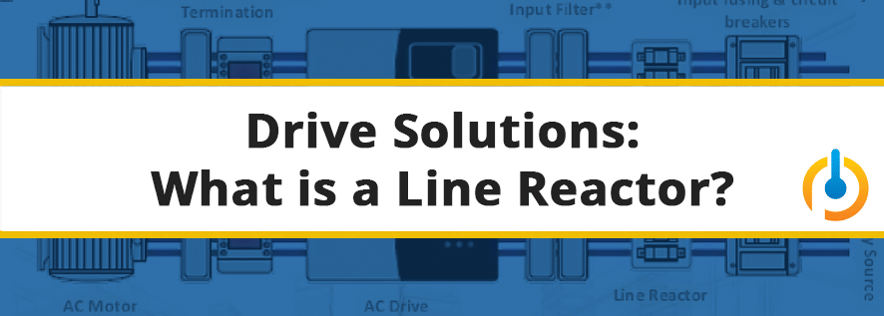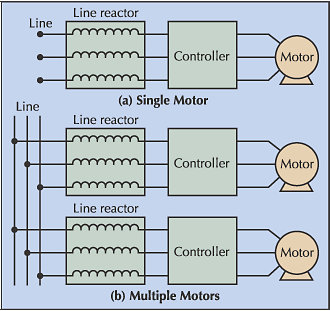
A line reactor (also referred to as a "choke") is a variable frequency drive (VFD) accessory. It consists of a coil of wire that forms a magnetic field as current flows through it. This magnetic field limits the rate of rise of the current, thus reducing harmonics and protecting the drive from power system surges and transients.
There are two primary types of line reactors used in variable frequency drives: AC & DC.
When an AC reactor is placed between the power system and the drive, it is referred to as an AC line reactor. When a DC reactor is inserted into the DC link of a variable frequency drive, it is known as a DC link reactor.
Both AC and DC reactors limit harmonic currents. However, AC reactors have the significant advantage of protecting the entire VFD from power system surges and transients since they are placed between the power system and the incoming power terminals at the drive. Reactors can prevent overvoltage trips, increase the reliability and lifespan of variable frequency drives, improve total power factor, and reduce nuisance tripping.
Typical drive applications of AC line reactors:
- Oil and Gas pumps
- Irrigation fields
- Water and Wastewater Treatment
- HVAC
- Steel Manufacturing
- Pulp and Paper
- Machining
- Extruders
How will Line Reactors help your Variable Frequency Drive?
While VFD's provide great advantages in energy savings and increased manufacturing efficiency, they are the #1 cause of electrical power system pollution. Reactors have become the most common means of reducing this pollution (or dirty power) and are popular as drive solutions.
VFD's tend to hog current to recharge their capacitors each time the AC voltage reaches a peak. This results in short bursts of current, as opposed to the normal sine wave that the utility expects to see. Think of it as flushing a toilet when someone is taking a shower, the water pressure in the shower drops suddenly.
These short bursts of current have the same effect on the electrical power system, causing voltage drops in the power system and distortion of the voltage waveform.
The magnitude of this distortion is referred to as either Total Harmonic Current Distortion (THID) or Total Harmonic Voltage Distortion (THVD). The larger the VFD, the more it will affect the power system. Think of this as noise that will pollute the power system, even traveling to neighboring facilities down the road.
 Line Reactor Diagram
Line Reactor Diagram
An AC line reactor can eliminate about 65% of THID. Although not perfect, this is a vast improvement. High peak currents can also cause fuse degradation and intermittent blowing of fuses or tripping of circuit breakers. AC line reactors also protect the VFD from power system surges and can prevent overvoltage trips. Line reactors typically have either 3% (Low-Z) or 5% (High-Z) impedance. 5% impedance line reactors will provide lower THID and provide better protection than 3% line reactors.
Why do our engineers recommend Line Reactors?
After reading this so far, you probably already have the idea that reactors can help your VFD.
Here are 16 reasons why our team of engineers at Premier Automation recommends line reactors:
- Easy to add to an existing VFD
- Provides surge protection for the VFD
- Increased reliability and lifespan of the VFD
- Provides some protection against overvoltage trips
- A cost-effective solution to reduce harmonic distortion
- Provides some buffering against voltage spikes
- Brings the facility into compliance with utility standards
- Avoids litigation and damage settlements
- Reduces the amount of high frequency noise injected into the power system.
- Improves true power factor
- Reduces cross-talk between drives
- Prevents fuses and circuit breakers from blowing or tripping due to high current spikes
- Provides needed impedance between VFD's and power system capacitors
- Protects capacitors and other power system components from harmonic resonance
- Frees up system capacity by reducing current levels
- Reduces intermittent faults and problems of unknown origin
Our team of experienced drive engineers recommends that all variable frequency drives should include reactors, at a minimum, for control of harmonics and power system pollution. Line reactors are the commonly preferred method of harmonic correction due to their effectiveness, reliability, and low cost. AC line reactors, or a combination of AC and DC reactors, will provide enhanced surge protection in addition to harmonic mitigation.
Standards of Measurement
IEEE 519 (IEEE Recommended Practices and Requirements for Harmonic Control in Electrical Power Systems) is the harmonic standard that is universally used in determining acceptable limits for power system distortion. This standard allows from 5% to 20% Total Harmonic Current Distortion (THID) depending on the "stiffness" of the power system.
The Point of Common Coupling (PCC), which is the closest point on the utility side of the customer's service where another utility customer is or could be supplied, serves as the point of measurement. While the approximate 30% THID from a drive utilizing line reactors is greater than the allowable limits, the current is typically diluted by other cleaner loads within the facility, thus bringing the overall facility into compliance. If this is not the case, there are other harmonic reduction techniques that can be brought to bear, but at a significantly higher cost than line reactors.
The Big Idea About Line Reactors:
AC line reactors applied to the line side of a variable frequency drive will improve THID and increase reliability and longevity. It's an optional accessory that will provide strong insurance at a reasonable price!
Premier Automation's team of engineers and service personnel are experts and have worked with, upgraded, designed, and repaired hundreds of drive applications. We specialize in a broad portfolio of automation solutions, including control system design, custom panel building, nationally ranked control system integration, and more.
If you're seeking a true electrical control partner for your next project, contact one of our engineers for a free consultation. Find out how Premier Automation can deliver innovative answers to your toughest automation questions.



